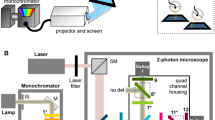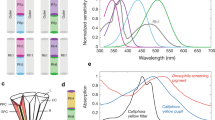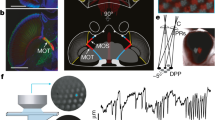Abstract
THE sensitivity of insect compound eyes to light varies with the previous illumination of the animal. A dark adapted eye has a lower threshold to light than the light adapted eye. Despite models1 which suggest a simple cause of this change, several factors are clearly at work. A rapid change in sensitivity occurs in the primary receptors themselves2: slower changes in sensitivity have been ascribed to pigment movements3., and changes in field size to movement of mitochondria and endoplasmic reticular spaces4. In the course of studies5 on the physiology of the retina of Dytiscus marginalis, I have discovered that light and dark adaptation is accompanied by large movements of the retinula cells. Examination of the retina of the giant water bug, Lethocerus americanus, has revealed a similar phenomenon.
This is a preview of subscription content, access via your institution
Access options
Subscribe to this journal
Receive 51 print issues and online access
$199.00 per year
only $3.90 per issue
Buy this article
- Purchase on Springer Link
- Instant access to full article PDF
Prices may be subject to local taxes which are calculated during checkout
Similar content being viewed by others
References
Fuortes, M. G. F., and Hodgkin, A. L., J. Physiol., 172, 239 (1964).
Naka, K. I., and Kishida, K., in The Functional Organization of the Compound Eye, 251 (Pergamon Press, 1966).
Höglund, G., in The Functional Organization of the Compound Eye, 77 (Pergamon Press, 1966).
Horridge, G. A., and Barnard, P. B. T., Quart. J. Micros. Sci., 106, 131 (1965).
Horridge, G. A., Walcott, B., and Ioannides, A., Proc. Roy. Soc., B (in the press).
Horridge, G. A., Tissue and Cell (in the press).
Olla, B. L., and Marchioni, W. W., Biol. Bull., 135, 530 (1968).
Solavalta, O., Tuurala, O., and Oura, A., Ann. Acad. Sci. Fenn., A., 4, 5 (1962).
Sato, S., Sci. Rep. Tohoku Univ. ser. 4, 19, 29 (1951).
Ludtke, H., Z. Vergl. Physiol., 35, 129 (1953).
Author information
Authors and Affiliations
Rights and permissions
About this article
Cite this article
WALCOTT, B. Movement of Retinula Cells in Insect Eyes on Light Adaptation. Nature 223, 971–972 (1969). https://doi.org/10.1038/223971a0
Received:
Issue Date:
DOI: https://doi.org/10.1038/223971a0
This article is cited by
-
Insect reactions to light and its applications to pest management
Applied Entomology and Zoology (2013)
-
Photomechanical changes in the ommatidia of theLimulus lateral eye during light and dark adaptation
Journal of Comparative Physiology (1974)
-
Adaptation and temporal characteristics of the insect visual response
Journal of Comparative Physiology (1973)
-
The electrophysiology of the retina ofPeriplaneta americana L.
Journal of Comparative Physiology (1973)
-
Die Feinstruktur im Auge der Biene bei Hell- und Dunkeladaptation
Journal of Comparative Physiology (1972)
Comments
By submitting a comment you agree to abide by our Terms and Community Guidelines. If you find something abusive or that does not comply with our terms or guidelines please flag it as inappropriate.



